Contents
Garlic is an extremely popular culture. It is grown in almost every garden or country house. Of particular interest to vegetable growers are winter varieties, which are characterized by high productivity, unpretentiousness, and most importantly, they have large teeth and excellent taste. Komsomolets winter garlic has all these qualities – a universal variety that, with the right agricultural technology, is capable of producing very high yields.
Variety description
Komsomolets is considered one of the best and proven varieties of winter garlic. Its history dates back several decades, when in 1969 Voronezh breeders at the seed station of the Research Institute of Vegetable Economy began work on breeding a garlic variety, zoned specifically for the farms of the Central Black Earth Region. As a result of this selection work, a winter-hardy, unpretentious variety, which received such a loud name for that time, was bred from local crops and almost 10 years later finally zoned.
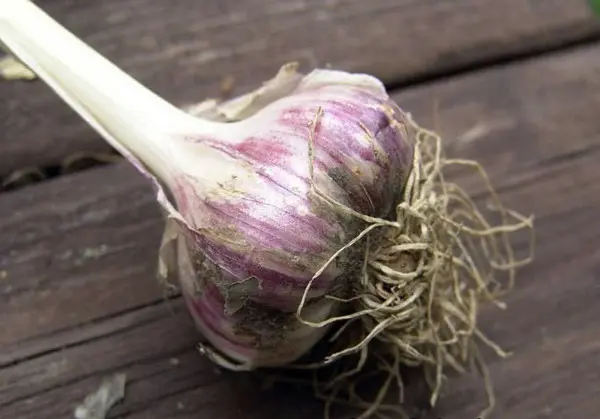
For many years, Komsomolets migrated from his homeland, and now it is grown everywhere. The variety has high frost resistance, unpretentious, relatively resistant to many diseases, including bacterial rot. In terms of ripening time, it belongs to mid-ripening varieties – the period of its full vegetation from germination to lodging of leaves is 110–120 days, but in the southern regions it can be reduced to 100 days. The yield of garlic is high: 1,2–1,4 kg / 1 sq. m.
The biological description of the variety is as follows: the stems are dense, consisting of 7–9 dark green, long (up to 40 cm) leaves, covered with a slight wax coating. Predisposed to the formation of arrows. On each arrow 0,8–1,2 m long, several hundred small air bulbs ripen. Feathers are juicy, have a mild taste, so they are often eaten fresh.
The bulbs are characterized by the following description: dense heads, consisting of 7–11 simple, equal-sized cloves. The bulbs are medium-sized, weighing 30–40 g, but in good soil they can grow up to 100–110 g. The pulp of the teeth is firm, juicy, and tastes spicy. The heads are covered with dense, gray-white scales with a brown or purple tint. The variety is well adapted to any climate, but it is most successfully cultivated in the regions of the Central Black Earth Region.
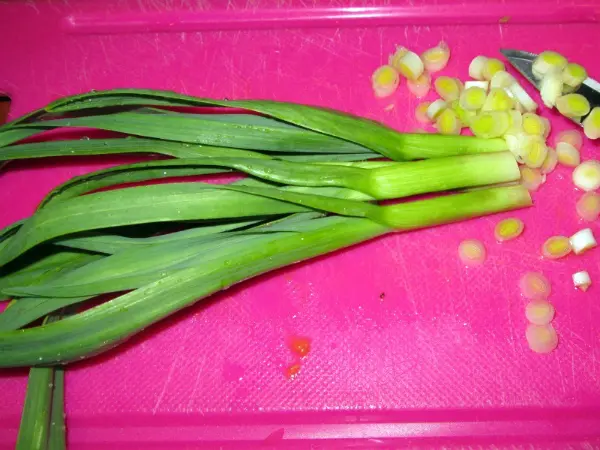
Subtleties of landing
In order for this variety of garlic to please with high yields, it is necessary to take into account some features of its planting.
Despite the fact that Komsomolets belongs to cold-resistant crops, it should be planted in a brightly lit garden, because even in partial shade the bulbs will grow small, with a low content of esters.
Garlic of this variety does not tolerate excessive soil moisture. This point should be taken into account when watering, as well as when locating and preparing the beds.
This winter garlic prefers loose loamy or sandy soil. If the soil in your area is heavy, you can improve its drainage properties by adding peat or river sand. The soil for growing this variety of garlic needs fertile, well-fertilized – during digging, it is necessary to simultaneously add humus (compost) and mineral mixtures.
Komsomolets grows better after legumes, cucumbers, zucchini, cabbage. This winter variety should not be planted after potatoes, onions, tomatoes. It is important to observe the principle of crop rotation and not plant garlic for two years in a row in one place.
For planting, only high-quality material should be selected: the largest and healthiest cloves or seed bulbs. Before planting, they must be disinfected in a solution of potassium permanganate, salt or copper sulfate.
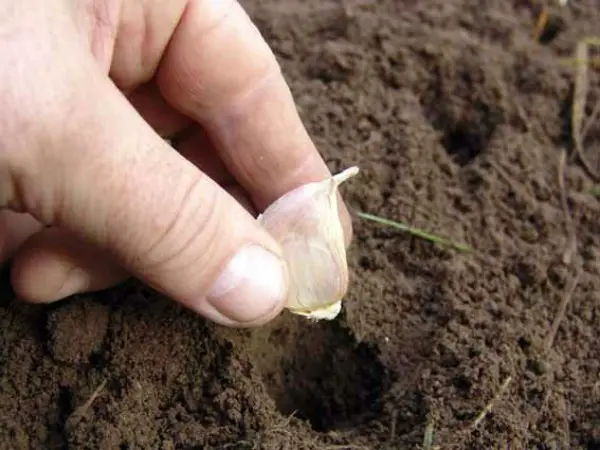
This winter variety is planted in the ground in mid-autumn – in the first half of October, however, in the northern regions, the planting time may be earlier.
The teeth are planted at a distance of 10 cm from each other, the bulbs – 6-8 cm, depending on the size. Row spacing should be 25-35 cm.
As for the depth of planting, the teeth are buried in the ground by 5–6 cm, and the bulbs by 2–3 cm.
Reproduction
Since Komsomolets belongs to the arrowing varieties of garlic, its reproduction is possible in two ways:
- parts of the bulb (teeth);
- aerial seed bulbs.
The first method is the easiest, because it allows you to get a crop for the next year. Reproduction by bulbs is a more complex and lengthy process, stretched in time for 2 years.
If small bulbs are planted in the soil in the fall, then in the summer of next year you will get large single-toothed bulbs that need to be planted again for the winter. And only in the summer of the third year a large and high-quality head of garlic grows from a single-toothed bulb. However, this method also has unconditional advantages – this is the renewal of seed material and cost-effectiveness.
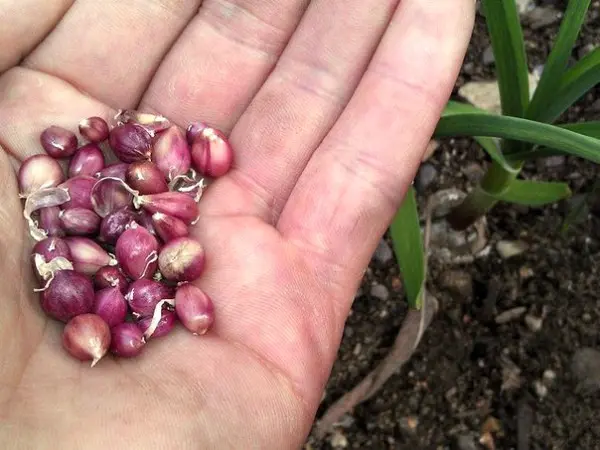
It is known that winter garlic tends to degenerate. Over time, its heads become smaller, lose their characteristic taste, and only new material (bulbs) is able to renew the variety.
The cost-effectiveness of the method lies in the fact that it is very profitable to grow seed with your own hands. Judge for yourself: in each inflorescence on the arrow, from 50 to 200 seed bulbs ripen, but this amount depends on the variety. For example, Komsomolets is especially prolific – several hundred seeds can ripen on its arrows at once. It turns out that only five arrows left in the garden allow you to get about a thousand high-quality fresh specimens for sowing.
Whatever method of propagation of garlic you choose, the main condition for high yields is high-quality seed. Both teeth and bulbs for planting should be selected the largest.
As a rule, when sowing, they are guided by the weight of the teeth – per 1 sq. m. about 100 g of onions are sown.
Despite the fact that Komsomolets is a winter variety, its seeds (bulbs) in the first year can be sown in the soil not only in autumn, but also in early spring.
Care
In many regions, garlic is mulched immediately after planting. Komsomolets easily tolerates frosts, but if the winter is expected to be harsh and with little snow, the bed needs a reliable shelter. Any organic matter can be used as a mulching material: sawdust, rotted manure, peat.
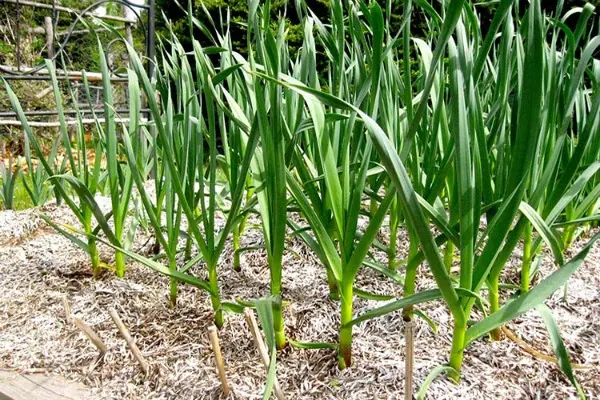
All other care activities begin in the spring. As soon as the snow melts, the mulch must be removed and the soil slightly loosened – this procedure will ensure oxygen access to the roots.
During the active growing season, the Komsomolets variety needs moderate but frequent watering – excessive moisture harms the plants, so it is necessary to water as the soil dries. A month before the planned harvest, watering is stopped so that the garlic ripens and acquires a characteristic bitter taste.
Top dressing during the entire spring-summer period is carried out 2-3 times. Fertilizers are applied at the same time as watering. From mineral mixtures, ammofoska (15 g / 1 sq. M) is used for feeding garlic, liquid mullein can be added from organics.
If the bed is not mulched, it is necessary to periodically loosen the aisles and remove weeds. If obtaining seeds is not the goal of growing Komsomolets garlic, then from time to time you also need to remove the arrows. Break off the arrow very carefully at the base of the top sheet. It is most reliable to remove the arrow when it reaches a height of 10–15 cm.
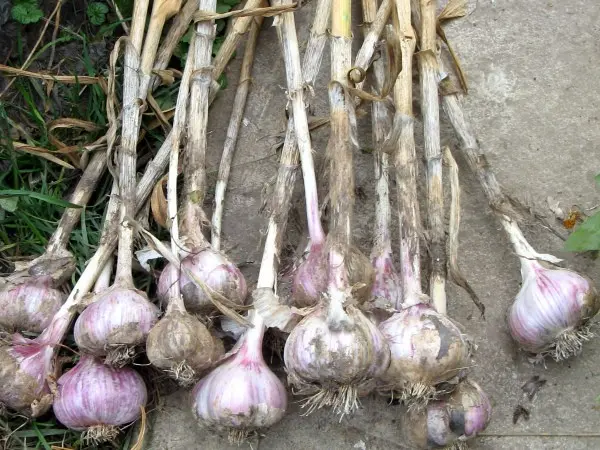
Cleaning
Komsomolets fully matures within 105-110 days from the appearance of the first shoots. On average, after three months, garlic can already be dug up, but first you need to make sure that it is ready for harvesting by external signs. So you can dig bulbs if:
- feathers turned yellow by 2/3;
- the lowest leaves withered;
- the stalk at the base has thinned or fallen down;
- the seed pods on the arrows are cracked;
- covering scales became dense, slightly transparent.
It is recommended to dig garlic on a sunny morning, and then lay out the crop right on the garden bed so that the bulbs dry out before evening. After that, the heads are transferred to the room or under cover and dried there for 2-3 weeks. The stems are cut only after complete drying.
It is very important to correctly calculate the time of harvesting the crop, since overripe garlic, like unripe garlic, is poorly stored and does not have such a pronounced taste and aroma.
Video “Planting garlic before winter”
This video tells about the secrets of planting and growing winter garlic.









